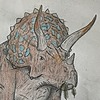HOME | DD
 Olmagon — A Day in the Elliot Formation
Olmagon — A Day in the Elliot Formation

#night #sauropod #osmundaceae #trailcam #lanasaurus #paleotrailcam #desert #dilophosaur #dinosaur #jurassic #mesozoic #paleoart #paleontology #prosauropod #sunset #theropod #lycorhinus #heterodontosauridae #paleoillustration #sauropodomorpha #antetonitrus #aardonyx #crocodylomorpha #araucariaceae #cameratrap #dracovenator #mammaliaform #litargosuchus #lessemsauridae #ledumahadi
Published: 2022-06-25 00:21:04 +0000 UTC; Views: 11006; Favourites: 169; Downloads: 7
Redirect to original
Description
Drawing made as a submission for the PaleoTrailCams paleostream challenge being hosted by Joschua Knüppe. Basically drawing 2 to 4 slides of paleoart made to look like they were photographs taken by a trail camera trap. I decided that since it's Jurassic June (does the paleo community still do that?) I'd choose to set up my camera trap in a Jurassic environment, and went with the Upper Elliot Formation in the Karoo Basin of South Africa, dating around 199 million years ago during the early Jurassic period. Four slides are included, one from the morning, midday, late afternoon and night each of the same day.I tried my best to research for the environment and everything of the Upper Elliot Formation, and this Google Doc I found has been an excellent help. The habitat was semi-arid, foliage being mainly conifers, ferns and cycads, with some shallow streams where horsetail grew nearby. The plants visible in these slides are some Osmundaceae ferns (based on fossil spores of cf. Punctatisporites obliquus and some araucarian trees (based on fossil wood of Agathoxylon sp./ Araucarioxylon africanum), though bare sand is still mostly visible. I tried my best to figure out what moon phase it was on May 23rd 199,000,000 BCE (the day these slides are set) but it's very difficult to calculate that far back, though my result was a waxing crescent (idk if this is right though so if you have no life and find thus interesting for some reason feel free to try finding out yourself).
Anyways here's the animals included:
Top left (morning): A Ledumahadi mafube climbs up the ledge and into the camera trap's shot in the back. Growing 9 to 10 meters long, this lessemsaurid (a basal sauropod family) was one of the largest land animals alive in its time, and possibly the largest land animal ever up until that point in time (though it would lose this title to later sauropods). Color scheme is loosely inspired by the banded rubber frog.
Top right (midday): An Aardonyx celestae stands upright to try to intimidate its predator, a Dracovenator regenti. A 6 to 7-meter long basal sauropodomorph, Aardonyx is shown to be capable of walking both bipedally and quadrupedally, and may have been able to defend itself by swiping at predators with its large thumb claws. For whatever reason I chose to base itscolor scheme on a bontebok antelope. Meanwhile the similarly-sized Dracovenator is a predatory theropod dinosaur of the Dilophosauridae family and one of the top predators of the Upper Elliot Formation, hunting the many medium-sized sauropodomorphs it lived alongside. Unfortunately known only from fragmentary remains (and some are now lost), Dracovenator may have been similar physically to its relative Dilophosaurus though if it did indeed have a similar parallel pair of head crests, these crests were likely smaller.
Bottom left (late afternoon): An Antetonitrus ingenipes stands in the shot whilst a Litargosuchus leptorhynchus makes itself look big rearing up right in front of the camera in the foreground despite being a much smaller animal. Another member of the Lessemsauridae family like Ledumahadi, Antetonitrus was about 8 meters long and thus large herbivore is one of the oldest known sauropods. Litargosuchus is not a dinosaur but a crocodylomorph, but being just around 70 centimeters long it is much smaller than living crocodilians, and its long slender limbs suggests it chased down small prey on land and wasn't aquatic. Whether it could rear up like shown here is speculative though, and it would have mainly walked on a fours.
Bottom right (night): A Lycorhinus angustidens stands very close to the camera whilst a Megazostrodon rudnerae walks across a log even closer to the camera still. At 1.2 meters long, Lycorhinus is a small ornithischian dinosaur of the Heterodontosauridae family, and likely was omnivorous or herbivorous. It may also be known to some under its synonym Lanasaurus scalpridens. As seen by the fossils of another heterodontosaurid, Tianyulong, the dinosaurs of this family were covered in feather quills across the body. Meanwhile Megazostrodon is one of the oldest known mammaliaformes (though probably lies outside the true Mammalia class).At around 12 centimeters long this tiny creature hunted insects and worms, likely at night, similarly to extant shrews.
Related content
Comments: 11

👍: 0 ⏩: 0

👍: 0 ⏩: 1

👍: 0 ⏩: 1

👍: 0 ⏩: 1

👍: 2 ⏩: 1

👍: 0 ⏩: 1

👍: 0 ⏩: 0

















